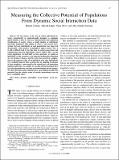Measuring the Collective Potential of Populations From Dynamic Social Interaction Data
Author(s)
Cebrian, Manuel; Lahiri, Mayank; Oliver, Nuria; Pentland, Alex Paul
DownloadCebrian-2010-Measuring the Collec.pdf (652.7Kb)
PUBLISHER_POLICY
Publisher Policy
Article is made available in accordance with the publisher's policy and may be subject to US copyright law. Please refer to the publisher's site for terms of use.
Terms of use
Metadata
Show full item recordAbstract
In any society, is the way in which individuals interact, intentionally or unintentionally, designed to maximize global benefit, or does it result in a fundamentally non-egalitarian stratification of society, where a small number of individuals inevitably dominate? Our ability to observe and record interactions between individuals in real populations has improved dramatically with modern technological improvements, but it is still a difficult task to use this data to model cooperation and collaboration between individuals, and its global effect on the entire population. To shed light on these questions, we model an individual's value in society as an epistatic mathematical function of a set of binary choices, and the collective potential of a population as the expected value of an individual over time. Individuals try to selfishly improve their societal value by adopting the choices of their neighbors, constrained by the actual observed interaction topology and order. As a result, we are also able to investigate how far natural populations are from an optimal regime of functioning. We show that interaction topology has a large impact on collective potential, but the relative order of specific interactions seems to have a negligible effect.
Date issued
2010-08Department
Massachusetts Institute of Technology. Media Laboratory; Program in Media Arts and Sciences (Massachusetts Institute of Technology)Journal
IEEE Journal of Selected Topics in Signal Processing
Publisher
Institute of Electrical and Electronics Engineers
Citation
Cebrian, M. et al. “Measuring the Collective Potential of Populations From Dynamic Social Interaction Data.” IEEE Journal of Selected Topics in Signal Processing, 4.4 (2010): 677-686.© 2010 IEEE.
Version: Final published version
Other identifiers
INSPEC Accession Number: 11415794
ISSN
1932-4553